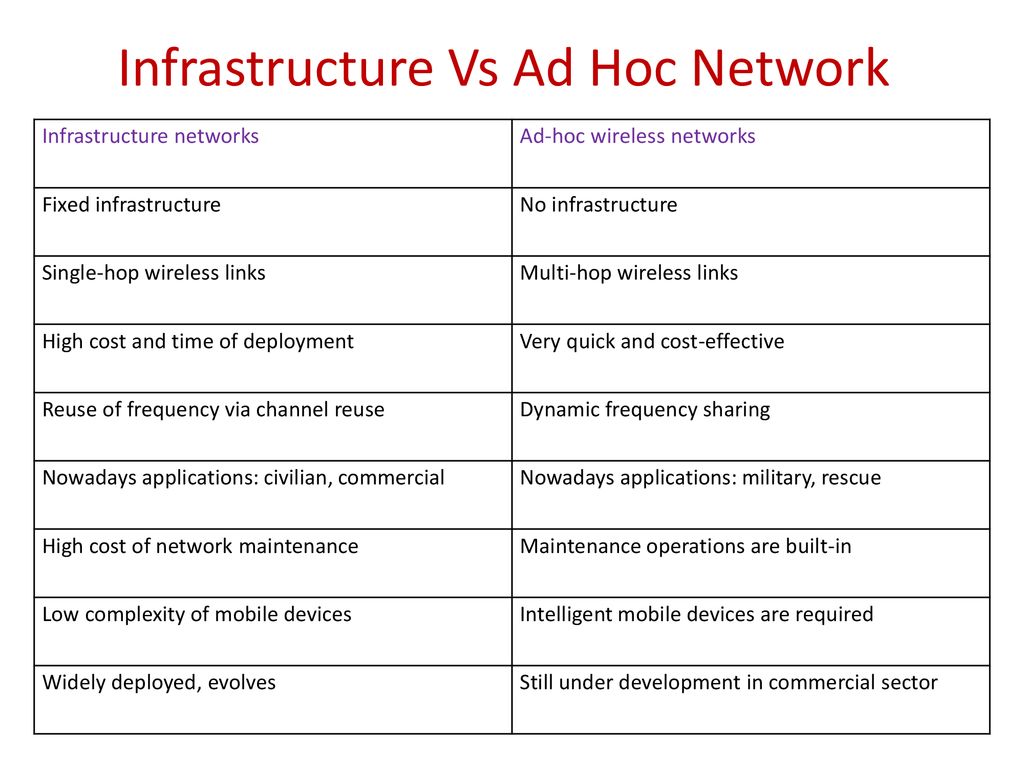What is the Difference between Ad-Hoc And Infrastructure Wireless Networks
In the realm of wireless networking, two primary setups are prevalent: Ad-Hoc and Infrastructure networks. While both serve the purpose of enabling wireless connectivity, they operate differently and cater to distinct needs and scenarios. Let’s delve into the dissimilarities between these two network configurations:
Ad-Hoc Wireless Network
An Ad-Hoc network is a decentralized type of wireless network where devices communicate directly with each other without the need for a central access point or router. This setup is typically used for temporary or small-scale wireless connections.
Infrastructure Wireless Network
Conversely, an Infrastructure network relies on a centralized access point, such as a Wi-Fi router, to facilitate communication between devices. These networks are more commonly found in homes, offices, and public spaces where multiple devices require stable and reliable connections.
Main Differences
| Aspect | Ad-Hoc Network | Infrastructure Network |
|---|---|---|
| Connection Method | Devices communicate directly | Communication through access point |
| Network Dependency | Independent devices | Relies on access point |
| Scalability | Primarily for temporary or small setups | Supports larger networks |

Credit: www.researchgate.net

Credit: slideplayer.com
Use Cases
Ad-Hoc networks are suitable for scenarios where quick setup and direct communication between devices are necessary, like peer-to-peer file sharing or temporary meetings. On the other hand, Infrastructure networks are ideal for establishments requiring stable and prolonged wireless connectivity, such as homes, offices, and public areas.
Pros and Cons
- Ad-Hoc Networks: Quick to set up, suitable for direct communication, not ideal for larger networks.
- Infrastructure Networks: Stable connections, scalable, requires an access point for communication.
Frequently Asked Questions Of What Is The Difference Between Ad-hoc And Infrastructure Wireless Networks
What Is A Wireless Infrastructure Network?
A wireless infrastructure network includes hardware, software, and services working together for reliable wireless coverage.
What Is The Difference Between Ad Hoc Networks And Wireless Sensor Networks?
Ad hoc networks are temporary, and wireless sensor networks are for specific applications. Ad hoc uses radio waves, while sensor networks use various media. Ad hoc allows multiple device connections, impacting performance, unlike sensor networks.
What Is The Difference Between Network And Ad Hoc Network?
An ad hoc network is a temporary LAN that multiple devices can use simultaneously. Setting up an ad hoc network permanently makes it a LAN. On the other hand, a network refers to the sharing of resources, data exchange, and communication between devices, while network infrastructure includes the physical and virtual components that support network operations.
What Is The Difference Between Network And Infrastructure?
A network facilitates resource sharing, data exchange, and communication between devices. Network infrastructure refers to the physical and virtual components that support network operation. Ad hoc networks are temporary LANs, while infrastructure networks are permanent and offer more stability and performance.
Conclusion
Understanding the disparities between Ad-Hoc and Infrastructure wireless networks allows users to choose the appropriate setup based on their requirements. While Ad-Hoc networks offer direct connectivity without a central device, Infrastructure networks ensure stable and scalable connections through access points.
